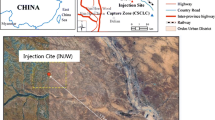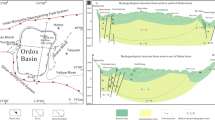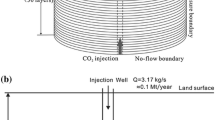Abstract
Among the risks of CO2 storage is the potential of CO2 leakage into overlaying formations and near-surface potable aquifers. Through a leakage, the CO2 can intrude into protected groundwater resources, which can lead to groundwater acidification followed by potential mobilisation of heavy metals and other trace metals through mineral dissolution or ion exchange processes. The prediction of pH buffer reactions in the formations overlaying a CO2 storage site is essential for assessing the impact of CO2 leakages in terms of trace metal mobilisation. For buffering the pH-value, calcite dissolution is one of the most important mechanisms. Although calcite dissolution has been studied for decades, experiments conducted under elevated CO2 partial pressures are rare. Here, the first study for column experiments is presented applying CO2 partial pressures from 6 to 43 bars and realising a near-natural flow regime. Geochemical calculations of calcite dissolution kinetics were conducted using PHREEQC together with different thermodynamic databases. Applying calcite surface areas, which were previously acquired by N2-BET or calculated based on grain diameters, respectively, to the rate laws according to Plummer et al. (Am J Sci 278:179–216, doi:10.2475/ajs.278.2.179, 1978) or Palandri and Kharaka (US Geol Surv Open file Rep 2004–1068:71, 2004) in the numerical simulations led to an overestimation of the calcite dissolution rate by up to three orders of magnitude compared to the results of the column experiments. Only reduction of the calcite surface area in the simulations as a fitting procedure allowed reproducing the experimental results. A reason may be that the diffusion boundary layer (DBL), which depends on the groundwater flow velocity and develops at the calcite grain surface separating it from the bulk of the solution, has to be regarded: The DBL leads to a decrease in the calcite dissolution rate under natural laminar flow conditions compared to turbulent mixing in traditional batch experiments. However, varying the rate constants by three orders of magnitudes in a field scale PHREEQC model simulating a CO2 leakage produced minor variations in the pH buffering through calcite dissolution. This justifies the use of equilibrium models when calculating the calcite dissolution in CO2 leakage scenarios for porous aquifers and slow or moderate groundwater flow velocities. However, the selection of the thermodynamic database has an impact on the dissolved calcium concentration, leading to an uncertainty in the simulation results. The resulting uncertainty, which applies also to the calculated propagation of an aquifer zone depleted in calcite through dissolution, seems negligible for shallow aquifers of approximately 60 m depth, but amounts to 35 % of the calcium concentration for aquifers at a depth of approximately 400 m.









Similar content being viewed by others
References
Aeschbach-Hertig W (2005) Physikalische Eigenschaften des Wassers, Heidelberg
Arvidson RS, Ertan IE, Amonette JE, Luttge A (2003) Variation in calcite dissolution rates. Geochim Cosmochim Acta 67:1623–1634. doi:10.1016/S0016-7037(02)01177-8
Beims U (1983) Planung, Durchführung und Auswertung von Gütepumpversuchen. Zeitschrift für Angew Geol 29:482–490
Berner RA, Morse JW (1974) Dissolution kinetics of calcium carbonate in seawater: IV. Theory of calcite dissolution. Am J Sci 274:108–134. doi:10.2475/ajs.274.2.108
Beyer C, Li D, Lucia MD et al (2012) Modelling CO2-induced fluid-rock interactions in the Altensalzwedel gas reservoir. Part II: coupled reactive transport simulation. Environ Earth Sci 67:573–588. doi:10.1007/s12665-012-1684-1
Birkholzer J, Apps J, Zheng L et al (2008) Research project on CO2 geological storage and groundwater resources: Water quality effects caused by CO2 intrusion into shallow groundwater, Technical Report, October 2008. 472
Boving TB, Grathwohl P (2001) Tracer diffusion coefficients in sedimentary rocks: correlation to porosity and hydraulic conductivity. J Contam Hydrol 53:85–100. doi:10.1016/S0169-7722(01)00138-3
Brendler V, Richter A, Wilhelm S (2011) Thermodynamische Referenzdatenbasis. 1–16
Brunauer S, Emmett PH, Teller E (1938) Adsorption of gases in multimolecular layers. J Am Chem Soc 60:309–319. doi:10.1021/ja01269a023
Buhmann D, Dreybrodt W (1985a) The kinetics of calcite dissolution and precipitation in geologically relevant situations of karst areas, 1 Open System. Chem Geol 48:189–211. doi:10.1016/0009-2541(85)90046-4
Buhmann D, Dreybrodt W (1985b) The kinetics of calcite dissolution and precipitation in geologically relevant situations of karst areas, 2 Closed System. Chem Geol 53:109–124. doi:10.1016/0009-2541(85)90024-5
Busenberg E, Plummer LN (1986) A comparative study of the dissolution and crystal growth kinetics of calcite and aragonite. Stud Diagn 1578:139–168
Casey WH, Banfield JF, Westrich HR, Mclaughlin L (1993) What do dissolution experiments tell us about natural weathering? Chem Geol 105:1–15. doi:10.1016/0009-2541(93)90115-Y
Compton RG, Daly PJ (1987) The dissolution/precipitation kinetics of calcium carbonate: an assessment of various kinetic equations using a rotating disk method. J Colloid Interface Sci 115:493–498. doi:10.1016/0021-9797(87)90066-x
Cussler EL (2009) Diffusion: mass transfer in fluid systems. Cambridge University Press, p 631
Dethlefsen F, Haase C, Ebert M, Dahmke A (2012) Uncertainties of geochemical modeling during CO2 sequestration applying batch equilibrium calculations. Environ Earth Sci 65:1105–1117. doi:10.1007/s12665-011-1360-x
Dethlefsen F, Köber R, Schäfer D, al Hagrey SA, Hornbruch G, Ebert M, Beyer M, Großmann J, Dahmke A (2013) Monitoring approaches for detecting and evaluating CO2 and formation water leakages in near-surface aquifers. Energy Procedia 37:4886–4893. doi:10.1016/j.egypro.2013.06.399
Dreybrodt W, Buhmann D (1991) A mass transfer model for dissolution and precipitation of calcite from solutions in turbulent motion. Chem Geol 90:107–122. doi:10.1016/0009-2541(91)90037-R
Dreybrodt W, Lauckner J, Zaihua L et al (1996) The kinetics of the reaction CO2 + H2O + H+ + HCO3–, as one of the rate limiting steps for the dissolution of calcite in the system H2O–CO2–CaCO3. Geochim Cosmochim Acta 60:3375–3381. doi:10.1016/0016-7037(96)00181-0
Duan Z, Li D (2008) Coupled phase and aqueous species equilibrium of the H2O–CO2–NaCl–CaCO3 system from 0 to 250 °C, 1 to 1,000 bar with NaCl concentrations up to saturation of halite. Geochim Cosmochim Acta 72:5128–5145. doi:10.1016/j.gca.2008.07.025
Duan Z, Sun R (2003) An improved model calculating CO2 solubility in pure water and aqueous NaCl solutions from 273 to 533 K and from 0 to 2,000 bar. Chem Geol 193:257–271. doi:10.1016/S0009-2541(02)00263-2
Fahrner S, Schäfer D, Dethlefsen F, Dahmke A (2012) Reactive modelling of CO2 intrusion into freshwater aquifers: current requirements, approaches and limitations to account for temperature and pressure effects. Environ Earth Sci 67:2269–2283. doi:10.1007/s12665-012-1673-4
Finneran DW, Morse JW (2009) Calcite dissolution kinetics in saline waters. Chem Geol 268:137–146. doi:10.1016/j.chemgeo.2009.08.006
Fischer C, Arvidson RS, Lüttge A (2012) How predictable are dissolution rates of crystalline material? Geochim Cosmochim Acta 98:177–185. doi:10.1016/j.gca.2012.09.011
Gabriel G, Kirsch R, Siemon B, Wiederhold H (2003) Geophysical investigation of buried Pleistocene subglacial valleys in Northern Germany. J Appl Geophys 53:159–180. doi:10.1016/j.jappgeo.2003.08.005
Gaus I, Audigane P, André L et al (2008) Geochemical and solute transport modelling for CO2 storage, what to expect from it? Int J Greenh Gas Control 2:605–625. doi:10.1016/j.ijggc.2008.02.011
Gelhar LW, Welty C, Rehfeldt KR (1992) A critical review of data on field-scale dispersion in aquifers. Water Resour Res 28:1955–1974. doi:10.1029/92WR00607
Gong Q, Deng J, Wang Q et al (2010) Experimental determination of calcite dissolution rates and equilibrium concentrations in deionized water approaching calcite equilibrium. J Earth Sci 21:402–411. doi:10.1007/s12583-010-0103-3
Grathwohl P (1998) Diffusion in Natural Porous Media: contaminant transport, sorption/desorption and dissolution kinetics. 207
Haase C, Dethlefsen F, Ebert M, Dahmke A (2013) Uncertainty in geochemical modelling of CO2 and calcite dissolution in NaCl solutions due to different modelling codes and thermodynamic databases. Appl Geochem 33:306–317. doi:10.1016/j.apgeochem.2013.03.001
Klotz D (1991) Erfahrung mit Säulenversuchen zur Bestimmung der Schadstoffmigration. Neuherberg
Kump LR, Brantley SL, Arthur MA (2000) Chemical weathering, atmospheric CO2, and climate. Annu Rev Earth Planet Sci 28:611–667. doi:10.1146/annurev.earth.28.1.611
Lasaga AC (1984) Chemical kinetics of water-rock. J Geophys Res 89:4009–4025. doi:10.1029/JB089iB06p04009
Lemieux J-M (2011) Review: the potential impact of underground geological storage of carbon dioxide in deep saline aquifers on shallow groundwater resources. Hydrogeol J 19:757–778. doi:10.1007/s10040-011-0715-4
Liu Z, Dreybrodt W (1997) Dissolution kinetics of calcium carbonate minerals in H2O–CO2 solutions in turbulent flow: the role of the diffusion boundary layer and the slow reaction H2O + CO2 = H+ + HCO3–. Geochim Cosmochim Acta 61:2879–2889. doi:10.1016/S0016-7037(97)00143-9
Merkel B, Planer-Friedrich B (2008) Groundwater geochemistry: a practical guide to modeling of natural and contaminated aquatic systems. 242
Mitiku AB, Li D, Bauer S, Beyer C (2013) Geochemical modelling of CO2-water-rock interactions in a potential storage formation of the North German sedimentary basin. Appl Geochem 36:169–186. doi:10.1016/j.apgeochem.2013.06.008
Morse JW, Arvidson RS (2002) The dissolution kinetics of major sedimentary carbonate minerals. Earth-Sci Rev 58:51–84. doi:10.1016/S0012-8252(01)00083-6
Ohse W (1983) Lösungs-und Fällungserscheinungen im System oberflächennanhes unterirdisches Wasser, gesteinsbildende Minerale -eine Untersuchung auf der Grundlage der chemischen Gleichgewichtsthermodynamik. Dissertation, Christian-Albrechts-Universität zu Kiel
Palandri JL, Kharaka YK (2004) A compilation of rate parameters of water–mineral interaction kinetics for application to geochemical modeling. US Geol Surv Open file Rep 2004–1068:71
Parkhurst DL, Appelo CAJ (1999) User’s Guide to PHREEQC (Version 2): a computer program for speciation, batch-reaction, one-dimensional transport, and inverse geochemical calculations. Water-Resour Investig Rep 99–4259:312
Peter A, Lamert H, Beyer M et al (2012) Investigation of the geochemical impact of CO2 on shallow groundwater: design and implementation of a CO2 injection test in Northeast Germany. Environ Earth Sci 67:335–349. doi:10.1007/s12665-012-1700-5
Pickens JF, Grisak GE (1981) Scale-dependent dispersion in a stratified granular aquifer. Water Resour Res 17:1191–1211. doi:10.1029/WR017i004p01191
Pitzer KS (1973) Thermodynamics of electrolytes. I. Theoretical basis and general equations. J Phys Chem 77:268–277. doi:10.1021/j100621a026
Pitzer KS, Kim JJ (1974) Thermodynamics of electrolytes. IV. activity and osmotic coefficients for mixed electrolytes. J Am Chem Soc 1426:5701–5707. doi:10.1021/ja00825a004
Plummer LN, Wigley TML, Parkhurst DL (1978) The kinetics of calcite dissolution in CO2-water systems at 5–60 °C and 0.0–1.0 atm CO2. Am J Sci 278:179–216. doi:10.2475/ajs.278.2.179
Pokrovsky OS, Golubev SV, Schott J (2005) Dissolution kinetics of calcite, dolomite and magnesite at 25 °C and 0–50 atm pCO2. Chem Geol 217:239–255. doi:10.1016/j.chemgeo.2004.12.012
Reddy MM, Plummer LN, Busenberg E (1981) Crystal growth of calcite from calcium bicarbonate solutions at constant PCO2 and 25 °C: a test of the calcite dissolution model. Geochim Cosmochim Acta 45:1281–1291. doi:10.1016/0016-7037(81)90222-2
Robinson R, Stokes R (1959) Electrolyte solutions: The Measurement and Interpretation of Conductance. Chemical Potential and Diffusion in Solutions of Simple Electrolytes, Butterworths 559
Schulz HD (1988) Labormessung der Sättigungslänge als Maß für die Lösungskinetik von Karbonaten im Grundwasser. Geochim Cosmochim Acta 52:2651–2657
Sjöberg EL, Rickard DT (1984) Temperature dependence of calcite dissolution kinetics between 1 and 62 °C at pH 2.7–8.4 in aqueous solutions. Geochim Cosmochim Acta 48:485–493. doi:10.1016/0016-7037(84)90276-X
Svensson U, Dreybrodt W (1992) Dissolution kinetics of natural calcite minerals in CO2-water systems approaching calcite equilibrium. Chem Geol 100:129–145. doi:10.1016/0009-2541(92)90106-F
Talman SJ, Wiwchar B, Gunter WD (1990) Dissolution kinetics of calcite in the H2O-CO2 system along the steam saturation curve to 210°C. In: Spencer RJ, Chou I-M (eds) Fluid-Mineral Interact. A Tribut. to H. P. Eugster. Lancaster Press Inc, San Antonio, pp 41–55
Trautz RC, Pugh JD, Varadharajan C et al (2013) Effect of dissolved CO2 on a shallow groundwater system: a controlled release field experiment. Environ Sci Technol 47:298–305. doi:10.1021/es301280t
Wang S, Jaffe PR (2004) Dissolution of a mineral phase in potable aquifers due to CO2 releases from deep formations; effect of dissolution kinetics. Energy Convers Manag 45:2833–2848. doi:10.1016/j.enconman.2004.01.002
White AF, Peterson ML (1990) Role of Reactive-Surface-Area Characterization in Geochemical Kinetic Models. In: Melchior DC, Bassett RL (eds) chem. American Chemical Society, Washington, DC, Model. Aqueous Syst. II, pp 461–475
Wigley M, Kampman N, Dubacq B, Bickle M (2012) Fluid-mineral reactions and trace metal mobilization in an exhumed natural CO2 reservoir, Green River, Utah. Geology 40:555–558. doi:10.1130/G32946.1
Zheng L, Apps JA, Zhang Y et al (2009a) On mobilization of lead and arsenic in groundwater in response to CO2 leakage from deep geological storage. Chem Geol 268:281–297. doi:10.1016/j.chemgeo.2009.09.007
Zheng L, Apps JA, Zhang Y et al (2009b) Reactive transport simulations to study groundwater quality changes in response to CO2 leakage from deep geological storage. Energy Procedia 1:1887–1894. doi:10.1016/j.egypro.2009.01.246
Acknowledgments
This study was funded by the German Federal Ministry of Education and Research (BMBF), EnBW Energie Baden-Württemberg AG, E.ON Energie AG, E.ON Gas Storage AG, RWE Dea AG, Vattenfall Europe Technology Research GmbH, Wintershall Holding AG and Stadtwerke Kiel AG as part of the CO2–MoPa joint project in the framework of the Special Program GEOTECHNOLOGIEN. We would like to acknowledge the associate editor Dr. Rolf S. Arvidson and an anonymous reviewer whose thorough reviews helped to considerably improve the quality of this manuscript.
Author information
Authors and Affiliations
Corresponding author
Rights and permissions
About this article
Cite this article
Haase, C., Dahmke, A., Ebert, M. et al. Suitability of Existing Numerical Model Codes and Thermodynamic Databases for the Prognosis of Calcite Dissolution Processes in Near-Surface Sediments Due to a CO2 Leakage Investigated by Column Experiments. Aquat Geochem 20, 639–661 (2014). https://doi.org/10.1007/s10498-014-9240-0
Received:
Accepted:
Published:
Issue Date:
DOI: https://doi.org/10.1007/s10498-014-9240-0




